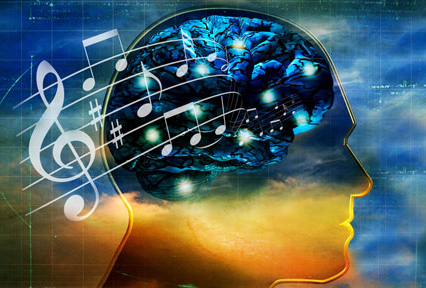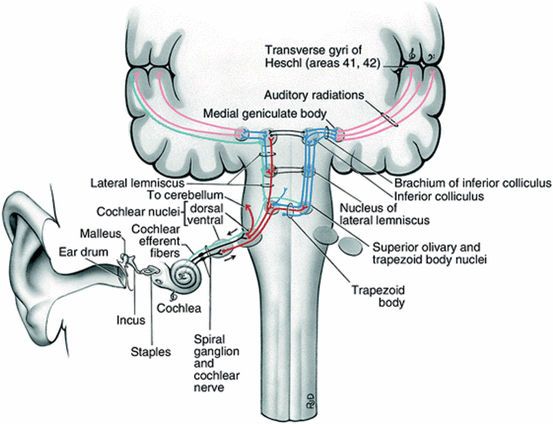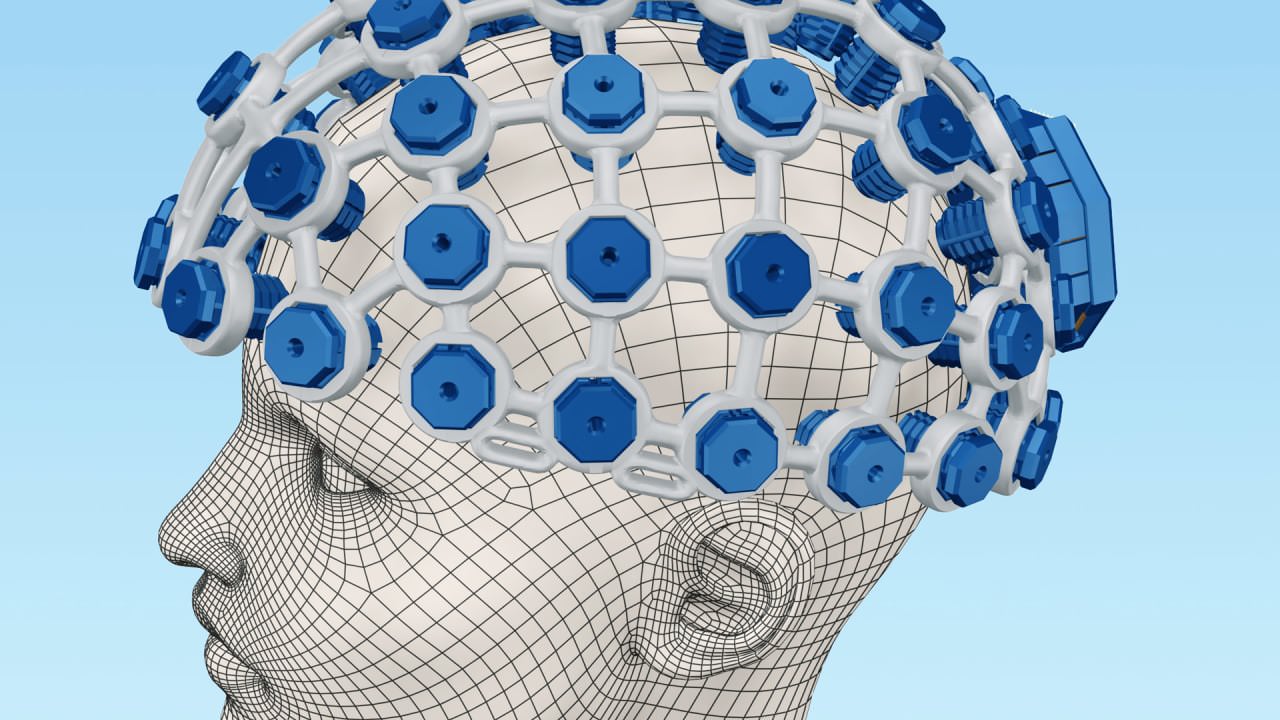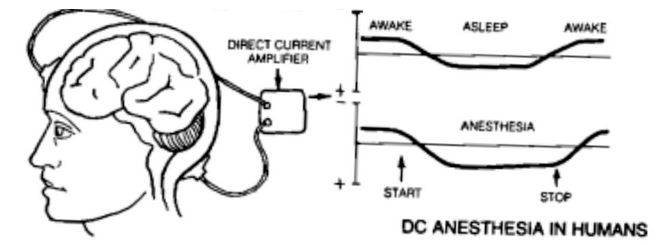While much of the focus of “hallucinatory” phenomena regarding DMT (both exogenous and endogenous (speculatively)) is based on the distinct visual experiences that take place… vision is but one of the human senses utilized to derive information. Auditory “hallucinations” seem to offer yet another layer of perceptual distortions that should be investigated in order to understand these experiences further. In Dr. Rick Strassman’s study in the early 1990’s, the high dose DMT experience encompassed not only distinctly profound visionary states but also included auditory sensations and interaction with the “beings” during these experiences. It’s not as if the volunteers experienced a vast array of colors, lights, shapes, and beings without any sound integration.
This is one of the factors that has led us to believe that there is the potentiality that endogenous DMT could possibly play a role in naturally occurring auditory “hallucinations”.Auditory hallucinations are generally described as occurring when a person hears voices and/or sounds that are not audible to other people. Endogenously produced auditory hallucinations have long been attributed to “mental illness” of various kinds including but not limited to schizophrenia as well as age-related neurodegenerative issues such as dementia, Parkinson’s, and Alzheimer’s disease. While the concept of “hearing voices” generally leads to the assumption that the occurrence takes place due to mental deficiencies or instabilities, this might not always be the correct assumption.

An epidemiological study published in 2002 in the British Journal of Psychiatry would survey 8,063 people (of various ethnicities) from ages 16 to 70 regarding experiences of auditory verbal hallucinations (AVH). It was found that 4% of the population experienced AVH but based on the screening process, only 25% of that group met the criteria for psychosis.
This alludes to the notion that 75% of people who experienced AVH in that group appeared mentally stable and healthy. In the past at DMT Quest, we’ve touched upon what appears to be anatomical atrophies/abnormalities to the schizophrenic brain (as well as Alzheimer’s, Parkinson’s & dementia) that have the potentiality to coincide with the experiential phenomena. It’s interesting to note that while meditation appears to enhance brain connectivity and anatomical structures, there have also been many anecdotal claims of “hallucinatory & auditory phenomena” coinciding with the practice. We hypothesize that endogenous DMT is involved in both the “hallucinatory” phenomena of schizophrenia as well as the transcendental states of meditation/trance.
Looking throughout history, notable figures such as Sigmund Freud, Carl Jung, Rene Descartes, Isaac Newton, Martin Luther King Jr., & Salvador Dali have all been cited to have experienced AVH at one point in time. These would appear to be humans with noticeably high degrees of functionality based on their accomplishments. Obviously this doesn’t allude to the fact that everyone who experiences AVH has increased cognitive ability or function.
*It’s interesting to note that both Isaac Newton and Salvador Dali were also included in our piece regarding consciously induced hypnagogia to generate insights… which we’ll touch upon later in this piece.
When deciphering the mystery of sound and AVH experiences, we must define what an audible frequency is. It’s formal definition is as follows: “An audible frequency is characterized as a periodic vibration whose frequency is audible to the average human. This frequency is measured in hertz (Hz) and is the property of sound that most determines pitch. The generally accepted standard range of audible frequencies for humans is 20 to 20,000 Hz although the range of frequencies individuals hear is significantly influenced by environmental factors. Frequencies below 20 Hz are generally felt rather than heard while frequencies above 20,000 Hz can sometimes be sensed by young people. High frequencies are the first to be affected by hearing loss due to age and/or prolonged exposure to very loud noises.”
Just to be clear, there is a distinct difference between frequencies cited in the electromagnetic spectrum (visual) compared to the sound spectrum (audio).
Electromagnetic waves are made up of an electric field that is oscillating… a magnetic field that is oscillating… while not needing a medium to travel in. By comparison, sound is a vibrational wave which travels by vibrating through some medium such as air or water. This is the reason that sound waves don’t travel in space while electromagnetic waves travel freely.
(Auditory Pathway)

(Description of the above image: The auditory pathway begins in the spiral ganglion of the cochlea where the axons of the spiral ganglion neurons form the auditory nerve. The auditory nerve penetrates through the skull and forms a first relay station at the level of the cochlear nuclei. Nerve fibers entering the cochlear nuclei are distributed in an organized manner… those that come from the apex of the cochlea (low frequencies) remain at the surface of the cochlear nuclei, whereas those of the base (high frequencies) penetrate deeper into the nuclei. This distribution allows each frequency to activate neurons located in a band that is sensitive to stimulation from a specific frequency.)
In a prior piece titled “DMT “Hallucinations” or Expansion of the Spectrum?”, we explored the potentiality that visual hallucinations possibly coincide with expansions of the visual spectrum outside the normal 390nm to 700nm range. We believe that there lies the possibility that measurable changes in the visual system coincide in synchronous measurable changes in the auditory system.
A 2016 study in The Journal of the Acoustical Society of America would observe significant pupil dilation of adult humans in direct response to varying frequencies of auditory stimulus. Pupil dilation inherently changes the amount of light the retina receives leading to subtle and/or potentially significant changes in perception. The term “cochleopupillary reflex” describes the occurrence of significant pupil dilation due to loud noise stimulus. A 2009 study in the Public Library of Science observed that auditory attention to sound sources (not passive) outside of a person’s visual field routinely activated peripheral regions in the visual cortex. A 2018 study published in the Proceedings of the National Academy of Sciences observed a never before seen occurrence regarding the movement of a person’s eardrums in-sync with their eye movements. These studies are interesting in the context of there being significant physiological connectivity and synergy between visual and auditory sensory organs/signaling pathways.
To complicate things further… similar to the 2014 study published in Psychological Science which observed that merely the thought of a light or dark environment could generate pupillary dilation or constriction, a 2005 fMRI study in Nature observed that the merely the thought of a sound could activate the auditory cortex of the brain. This seemingly insinuates that this world of perceptual “reality” might possibly be a bit more complex than simply neurological interpretation of external waves of various kinds.
This brings us back to the original question… what role does DMT play in auditory hallucinations?
Serotonin receptor (5-HT) activation has been often cited as forming the basis for playing a prominent role in DMT-related visionary states. However, DMT appears to significantly stimulate additional receptors outside of strictly 5-HT which include but are not limited to the following: Alpha-1A, Alpha-1B, Alpha-2A, Alpha-2B, Alpha-2C, D1, & Imidazoline-1.
A 2015 study in The Journal of Neuroscience would cite the concentration of 5-HT receptors (5-HT2A, 5-HT2C, 5-HT7) within the dorsal cochlear nucleus (DCN) of the mouse brain. The conclusion was as follows: Our findings reveal that 5-HT exerts a potent influence on fusiform cells by altering their intrinsic properties, which may enhance the sensitivity of the DCN to sensory input. A 2012 study in the journal Neuropharmacology would observe the effects of Alpha-2B receptor alterations regarding auditory cue detection in rats. A 1996 study in the journal Acta Oto-Laryngologica observed the presence of Alpha-1B receptors in the cochlea of the chinchilla.
While it has been observed that DMT stimulates these specific receptors (5-HT & Alpha), it doesn’t necessarily indicate that endogenous DMT is constantly modulating our auditory experience. There are other biochemicals such as serotonin and adrenaline/noradrenaline that are likely to stimulate these serotonergic and adrenergic receptors throughout the auditory system in normal waking consciousness. However, we do believe that there lies the possibility that altered states of consciousness potentially upregulate endogenous DMT synthesis which correlate with altered stimulation of these receptors in the auditory system.
(The reason for DMT Quest’s interest in auditory verbal hallucination (AVH) experiences is based on anecdotal reports by two long-time associates who privately confided that they experience AVH on a regular basis immediately prior to sleep. One gentleman is in his late 30’s and the other is in his mid 40’s. Both could be considered to be highly functioning members of society with one being a long-time business owner and the other being a senior biochemist at a local biotechnology firm. The fact that both men described very similar states of consciousness (hypnagogia) that correlated with the AVH experiences led us to postulate that there seem to be replicable mechanisms to the phenomena that apparently correlate with much of what we’ve covered thus far at DMT Quest.)
A 1989 study in the Polish journal Otolaryngologia Polska would observe the changes in hearing acuity of 30 human volunteers based on circadian rhythm. It was found that the highest hearing acuity coincided at night when body temperature was the lowest while the lowest hearing acuity coincided during the day when body temperature was the highest. This is intriguing considering the vast array of EEG & biochemical changes based on circadian rhythm with the main one’s being melatonin and speculatively the entire “Endohuasca”/DMT system. It’s also interesting based on the notion that if auditory acuity increases based on changes in consciousness and if AVH occurs alongside increases in auditory acuity… can we truly be comfortably assuming that all AVH is merely “hallucinatory” phenomena?
Questions, questions, and more questions!
*An in-depth review regarding the multi-layered effects of circadian rhythm and auditory function was published in 2018 in the journal Hearing Research.

A 1978 study in the journal Biological Psychiatry would compare the EEG activity of 6 unmedicated schizophrenic patients with AVH and 6 normal volunteers performing tests of creativity. The results were as follows: They reported that EEG power was predominant in the delta and theta bands in the 4 second interval prior to reports of hallucinations and creative responses, and suggested that the intrusiveness of the hallucinatory experience may be similar to the sudden internal experience of solving a creative task. A 2009 study in BMC Neuroscience observed a correlation between left auditory cortex gamma synchronization and auditory hallucination symptoms in schizophrenics. These 2 studies imply that the mechanisms for AVH appear to have much overlap with the hypnagogic technique utilized by Thomas Edison in which slow wave amplitude is initially increased by relaxative techniques while the fast wave burst occurs when Edison was jolted awake by a loud sound. Edison would claim that this technique would allow him to generate solutions to issues that he would have difficulties solving in his normal waking state.
In 2010, the journal Phenomenology and the Cognitive Sciences would publish a survey in which 325 healthy participants were asked about about AVH experiences during hypnagogic and hypnopompic states. 108 participants (33%) reported AVH’s in the hypnagogic/hypnopompic state.
As we’ve cited many times in the past, we believe that children (ages 8 and under) consistently exude brain activity and a biochemical make-up that “modern” adults generally do not experience. A 2006 study in Clinical Neurophysiology observed increased theta spectral power in infants and pre-school children. A 1998 study in the Japanese journal Acta Paediatrica Japonica observed age-related changes in gamma wave activity in 707 children from ages 3 to 12. It was found that gamma power increased significantly from ages 3 to 4 peaking at age 5 especially in the frontal region.
This data points to the notion that generally speaking, children up to 8 years old might essentially be navigating hypnagogic states on a consistent basis.
A 2011 study in The British Journal of Psychiatry generated a 5-year follow up on children who had experienced AVH at 7 & 8 years old. The persistence rate was 24% which equates to 76% of the children as no longer experiencing AVH once they reached the ages of 12 & 13. An unconnected 2007 study in the journal Human Brain Mapping utilized brain fMRI and EEG to measure age related changes in 138 healthy participants ages 10 to 30. Based on fMRI results, gray matter was negatively correlated with age while increased white matter was positively correlated with age. The EEG results observed a significant decrease in slow wave amplitude (especially frontal cortices) with increases in age.
These results suggest that it is a natural aspect of human development to experience different perceptual changes based on altered brain activity coinciding with maturation of physiology. This provides us our foundation with which to postulate that AVH is possibly associated with expansion/enhancement of the auditory spectrum rather than simply nonsensical “hallucinations”. We find it intriguing that some young children have been reported as being able to see further into the UV spectrum (as low as 310 nm) than average adults. Perhaps this ability isn’t necessarily separate from young children’s ability to hear sounds above the 20,000 Hz range? There appears to be significantly different brain activity and biochemical differences in young children to support the notion that there is enhanced sensory perception taking place. When you combine these observations with the results of the 1989 Polish study observing increased auditory acuity at night in adults (increased slow wave amplitude) compared to the daytime, it strengthens the notion further.
(While one of the most common equipment utilized to study the brain is the electroencephalogram (EEG), other devices such as functional magnetic resonance imaging (fMRI), positron emission tomography (PET) and magnetoencephalography (MEG) afford an additional layer of measurement in terms of brain activity. EEG measures electrical activity generated by the various cortical areas of the brain. fMRI measures brain function by detecting changes in blood flow associated with neural activity. PET uses trace amounts of short-lived radioactive material to map functional processes in the brain. MEG captures the magnetic fields generated by neural activity. One of the less popular forms of brain function measurement is called direct current (DC) brain potential. This device measures direction of the current in the brain by utilizing two electrodes placed at the front and back of the head to measure DC current. In Dr. Robert O. Becker’s book “The Body Electric”, he chronicles his observation of changes in the DC brain potential coinciding with changes in consciousness. Heightened states of awareness induced a strong negative frontal potential while sleep correlated with a strong positive frontal potential. This is important to note in terms of the correlating EEG data in which it appears as though AVH phenomena occurs alongside increased slow wave amplitude immediately preceded by fast wave bursts. In the case of DC brain measurement, it would appear that a burst of increased oscillatory activity takes place as frontal potential abruptly shifts from negative to positive to negative potential. This is merely an example of different insights possibly being generated based on changes in perception coinciding with having utilized differential equipment.)
(Example of DC brain measurement)

While much of the mainstream focus of auditory hallucinations in adults seems to veer towards the discussion of schizophrenia, autistic adults have been cited to have significantly altered auditory function compared to normal controls. A 2017 study in the journal Cognition compared the auditory capacity of 20 autistic and 20 non-autistic adults (ages 17 to 34 years old). It was observed that auditory perceptual capacity is significantly increased in autistic adults and while being beneficial in certain instances, could possibly be an underlying factor in terms of the sociological challenges faced by them. We find this intriguing regarding the potential ‘enhanced auditory capacity-DMT’ link based on the 2010 study in Neuro Endocrinology which observed that the urine of autistic subjects exuded over 200% more bufotenin (5-HO-DMT) than normal controls.
A 2017 study in the journal Brain measured the brain activity (fMRI) of 12 non-clinical voice hearers vs. 17 control subjects while passively listening to disguised speech sounds (‘sine-wave’ speech). Sine-wave speech is often described as sounding a bit like a birdsong or alien-like noises. Usually these sounds can only be understood once people are either told to listen out for speech, or have been trained to decode the disguised sounds. The results of the study found that nine out of 12 (75 per cent) voice-hearers reported hearing the hidden speech compared to eight out of 17 (47 per cent) non voice-hearers. On average, the voice-hearers also tended to notice it earlier than other participants who had no history of hearing voices. The results suggest the possibility that non-clinical voice hearers exude enhanced auditory processing capabilities compared to non voice hearers.
While adult humans have generally been cited as being limited to hearing sound waves between 20 and 20,000 Hz, there is periphery data alluding to the fact that inaudible sound waves outside of this bandwidth induce measurable physiological changes to the brain. Infrasonic sounds are classified as sound waves that exude a frequency below the 20 Hz threshold. A 2017 study in the journal Public Library of Sciences utilized fMRI equipment to measure the human brain’s response to sounds in the infrasonic range. The results were as follows: “The first study to demonstrate that infrasound (infrasonic sound) near the hearing threshold may induce changes of neural activity across several brain regions, some of which are known to be involved in auditory processing, while others are regarded as keyplayers in emotional and autonomic control.”
Ultrasonic sounds equate to sound waves comprising of frequencies 20,000 Hz and above. A 2000 study in the Journal of Neurophysiology utilized positron emission tomography (PET) and EEG equipment to measure potential changes in regional cerebral blood flow (rCBF) and brain activity from ultrasonic sounds (high frequency components (HFC)) in adult humans. The results were as follows: “None of the subjects recognized the HFC as sound when it was presented alone. However, alpha frequency recorded from the occipital region increased when the subjects were exposed to sound containing both an HFC and an LFC (low frequency component) compared with identical sound from which the HFC was removed (i.e., LFC alone). In contrast, compared with the baseline, no enhancement of alpha-EEG was evident when either an HFC or an LFC was presented separately. PET measurements revealed that, when an HFC and an LFC were presented together, the regional cerebral blood flow (rCBF) in the brain stem and the left thalamus increased significantly compared with a sound lacking the HFC above 22,000 Hz but that was otherwise identical. Simultaneous EEG measurements showed that the power of occipital alpha-EEGs correlated significantly with the rCBF in the left thalamus. Psychological evaluation indicated that the subjects felt the sound containing an HFC to be more pleasant than the same sound lacking an HFC. These results suggest the existence of a previously unrecognized response to complex sound containing particular types of high frequencies above the audible range. We term this phenomenon the “hypersonic effect.””
A 2014 study in the Public Library of Sciences utilized EEG equipment to further investigate the relationship between hypersonic effect and HFC (ultrasonic) frequencies. The findings were as followed: “Our results showed reciprocal directional changes in Alpha-2 EEGs depending on the frequency of the HFCs presented with audible low-frequency component (LFC). When an HFC above approximately 32 kHz was applied, Alpha-2 EEG increased significantly compared to when only audible sound was applied (positive hypersonic effect), while, when an HFC below approximately 32 kHz was applied, the Alpha-2 EEG decreased (negative hypersonic effect). These findings suggest that the emergence of the hypersonic effect depends on the frequencies of inaudible HFC.”
(Figure 5 of the 2014 PLOS Study above)

A 2006 study published in the journal Brain Research utilized EEG equipment to measure whether there were any differences in the “hypersonic effect” and listening comfortability of ultrasonic sound frequencies based on whether a person was exposed to the sound via headphones or had the sound projected to the entire body surface of the subject. It was observed that Alpha-EEG and comfortable listening level significantly increased only when the ultrasonic sound was broadcast to the subject’s body via speakers and not when presented via headphones. The conclusion of the study was as follows: “The present findings suggest that the conventional air-conducting auditory system alone does not bring about the hypersonic effect. We may need to consider the possible involvement of a biological system distinct from the conventional air-conducting auditory nervous system in sensing and transducing high-frequency elastic vibration above the human audible range.”
These findings appear to complicate our understanding of auditory phenomena a bit further being that our changes in perception are largely reflected in measurable changes in brain activity. If infrasonic and ultrasonic sounds can measurably alter audible sound perception and brain activity while remaining inaudible to the average human, there lies the possibility that our understanding of physiological sound processing is less developed than once believed.
So far we’ve covered quite an array of topics pertaining to AVH… a potential DMT receptor affinity link, increased slow wave amplitude preceding fast wave burst, circadian based changes in auditory acuity, natural AVH phenomenology among children that ceases with age, and the surprising effects of infra/ultrasonic sound on brain activity. Nevertheless, the question still persists… what do the voices themselves mean?
What is their origin? (Obviously neurological origin would be the first assumption but that hardly equates to it being correct. Biological correlates to an experience do not inherently explain the entire experience.)
Is it possible to interact with them? If so, can tangible, functional information be derived from these voices?
Are purported psychics hearing “voices” or making them up? Can the differences be deciphered from measuring EEG activity and biochemical composition?
Do “ghosts” and “spirits” interact with people on an auditory frequency that falls outside the normal spectrum 20 to 20,000 Hz? Is there a combination of audible and inaudible sound frequencies that induce the AVH experience?
Are there any yet undiscovered interactions between the electromagnetic spectrum and the sound spectrum?
What type of insights did Thomas Edison have in terms of developing equipment to record the voices of the dead?
AVH is inherently a very complex topic to discuss as there is such variation in terms of the subjects with which they occur. Obviously not all the subjects have the same neuroanatomy or environmental upbringing that coincides with the generation of AVH. This makes it very difficult to generalize regarding the phenomena but based on the commonality of AVH compared to visual hallucinations, it seems as though it could be a rich area of research if a person where to study this from a rational perspective.
PS- (Sound Levitation)
A 2017 study in The Journal of the Acoustical Society of America observed for the first time in modern history that acoustic standing waves can be employed to stably levitate an object much larger than the acoustic wavelength in air. Prior to this development, acoustic levitation techniques were mainly restricted to particles that were much smaller than the acoustic wavelength. The ramifications of this study has potentially heavy implications for the future… and possibly the past as well.
DMT Quest is a non-profit 501(c)3 dedicated to raising awareness and funds for endogenous DMT Research. This specific field of psychedelic research has been underfunded for many decades now. It’s time to take our understanding of human physiology, abilities, and perception to the next level. E-mail me at jchavez@dmtquest.org with any comments or questions. You can also follow us on Facebook, Instagram, or Twitter.
